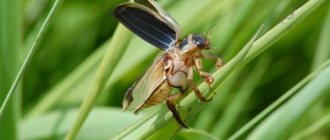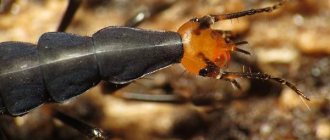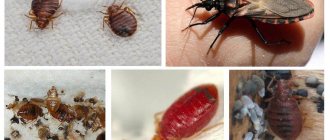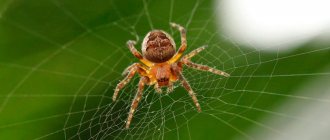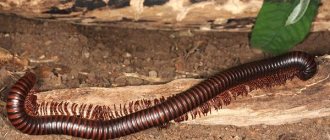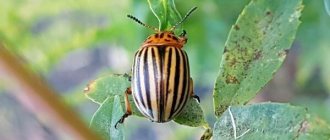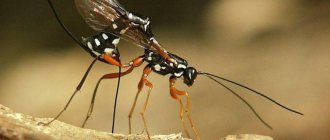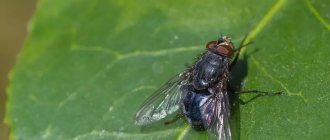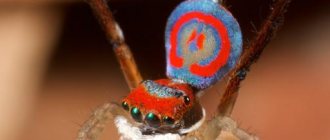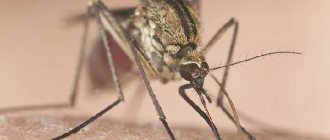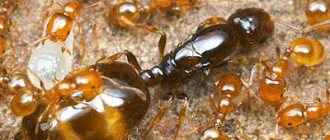Description of insects
Dung beetles (Geotupidae) are a family of beetles whose lifestyle is closely related to the earth. The scientific name is formed from two words geos - earth and trypeter - driller, digger. The beetles have an oval or round body shape, the adult size is 3-70 mm. The head is directed forward. The antennae, which are an excellent organ of touch, consist of 11 segments. The special structure of the 3-segmented club served as the name of the whole family. The organ's plates can open up like a fan. In some species the club is enveloping. The mandibles extend beyond the clypeus and are clearly visible from above.
The pronotum is convex, sometimes with tubercles, points and growths. The elytra of the dung beetle are thickened, protruding, the surface is grooved or smooth. In many species, the wings are well developed and are used for short flights in search of food. Some beetles have lost the ability to fly. The color of dung beetles can be black, brown, blue, green, yellow, and may have a metallic tint. The abdomen is colored blue or purple. It consists of 6 sternites on which 7 spiracles are located.
The coxae of the front legs are transverse, strongly protruding. The tibiae are serrated along the outer edge, with 2 spurs at the apex. This structure is typical for digging legs. The paws end in simple claws. The lateral surface of the limbs is covered with long black hairs.
Larva
Lamellaridae are insects with a full cycle of transformation. The larva of the dung beetle is C-shaped, characteristic of members of the family. Their body is cylindrical, thick and fleshy. The color is light - creamy white, beige, yellow. The head capsule is sclerotized, and in most species there is no frontal suture. The jaws are of a gnawing type, well developed. The head is painted brown. The antennae consist of three segments; there are no eyes.
Classification
The family Geotrupidae includes more than 600 species of dung beetles, a small part of them (20 pieces) live in Russia.
Dung beetles are divided into several subfamilies:
- The subfamily Bolboceratidae includes large and medium-sized beetles, most of which live in the Palearctic. The adult size is 15-23 mm, the antennae consist of 11 segments, the club - of 3 segments. The elytra are black, brown or two-colored. The wings are well developed and are used for flight. Adults feed on mushrooms, larvae on humus.
- The subfamily Geotrupinae are medium-sized beetles, characterized by protruding upper jaws and lips. The club is lamellar or enveloping. On the forelimbs there are 4-9 teeth along the outer edge. The basis of their diet is the excrement of mammals. The beetles also feed on mushrooms and forest litter.
- The subfamily Lethrinae are beetles with an oval, convex body, the length of which does not exceed 30-35 mm. A characteristic feature is the presence of mandible appendages on the upper jaw of males. The club is enveloping, its segments do not open in the form of a fan. The wings have lost their flight function. The beetles live in burrows; during the breeding season, males are aggressive towards rivals. Mating occurs on the surface. Leaves and shoots are harvested to feed the larvae. Lethrusapterus
Habitats of the common shrew
Many species of these beetles live on the African continent, Central Asia and Northern Europe. In short, they are common in many parts of the world.
In Russia you can find 20 species of beetles from 11 genera, but in certain northern regions (for example, Siberia) their diversity and abundance are much higher. Diggers even live in Australia, although they were brought there on purpose at one time. The reason for this is the positive impact they have through their activities.
Many years ago, this was simply necessary for the inhabitants of Australia, because due to an increase in livestock, green areas were significantly reduced, and the land in many places became like swamps. The beetles managed to correct the situation.
Insects can be found in pastures, meadows and forest edges - in a word, wherever there is grass and large mammals.
They live in minks, mostly different ones, but some species, which consist of related individuals of different generations, can coexist together. There are also species that live in semi-colonies. Adult dung beetles burrow into vertical and sometimes very deep burrows (the average depth is 15-200 cm, but can exceed two meters).
Common types of dung beetles
Anoplotrupesstercorosus
The forest dung beetle is found throughout Europe and is a widespread species. It lives in deciduous and mixed forests, with a particular preference for beech groves. The adult size is 12-20 mm. The elytra are black and blue, the lower part of the body is blue with a metallic tint. The elytra are covered with seven rows of dotted grooves. Colored wings are hidden under the hard elytra; they can be green, purple, or brown. The antennae are red-brown, with a large club.
The beetle is active from May to September. It digs holes 80-90 cm deep, at the end of which it equips a chamber for laying eggs. The larvae feed on lumps of herbivore faeces and leaf litter. The larvae overwinter and their development takes about a year. Adult beetles emerge in the spring.
Onthophagus gazella
Brown dung beetle from the scarab family. The insect is native to Africa. This species was introduced to Australia and North America to solve waste management problems in grasslands. Settlers from Europe brought with them large herds of cows and sheep. Local dung beetles (almost 400 species) were unable to rid pastures of manure. The area quickly became covered with animal waste.
To solve the problem, the beetle Onthophagusgazella, a hard-working and fast-growing insect, was chosen. The male and female make 10-12 balls of dung in which the offspring develop. The larval stage is 18-20 days, the pupal stage is 2 weeks.
Trypocoprisvernalis
A representative of the family Geotrupidae, the spring dung beetle lives in Europe, Asia Minor, and the Caucasus. A small insect 18-20 mm long has a convex oval body. There are almost no grooves on the elytra, the surface appears smooth. Only on the wide pronotum there are many points. The color is variable; there are individuals that are black-blue, green or dark blue. The surface of the elytra is glossy. The antennae are dark, the club is lamellar. There are two keels on the hind legs.
The spring dung beetle is a rare species, listed in the Red Book of several regions of Russia (Smolensk and Moscow), as well as Belarus. In places where many ungulates live, the insect is found in large numbers. For example, in Belovezhskaya Pushcha. The beetle prefers to settle on the edges and lawns of broad-leaved forests. Adults are found from May to September and are most active at dusk in spring.
Green shiny dung beetles are similar to bronze dung beetles, but differ in their lifestyle. The spring dung beetle rests during the day, flying out in the evening in search of dung heaps.
Females make burrows under piles of excrement. The depth of the shelter for the larva is 50-60 cm. At the bottom there is a chamber with balls of manure where the larva grows. The offspring overwinter and pupate in the spring. The reduction in the number of beetles is facilitated by a decrease in the number of cattle, deforestation and anthropogenic impact on their usual habitats.
Extemporaneousness
The common dung beetle is a beetle with a shiny black-blue surface. The species is distributed throughout the Palearctic. The body is oval, length 16-27 mm. The abdomen is blue with a metallic sheen, covered with black hairs. Each elytron has 7 grooves. The head is directed forward, antennae with three plate-like clubs. The beetles live in meadows and farmland. The main food is excrement of cattle and horses. For the offspring, holes are dug up to 60 cm deep, into which dung balls are placed. The female leaves a clutch of 3-6 eggs.
In one hole, dung beetles make several branches for each larva. Its nutrition is provided by a ball of dung, several times larger than the size of the beetle. Young adults emerge from the pupa in April. Insects are active at night. Slow-moving dung beetles have many natural enemies: birds, small mammals (moles, hedgehogs, foxes). The danger comes from small parasites: ticks. In case of danger, the common dung beetle is capable of creaking with its limbs, which is an alarm signal.
Anthropomorphous
The bull beetle belongs to the lamellar family. Caleaters are small, medium-sized beetles with a compact, flattened body. Their length is up to 15 mm. The two-horned horned beetle or bull beetle got its name from the paired outgrowths on the head of males. They are located on the back, front or middle of the head. Having met in the tunnel, the males try to push each other out. The insects rest their limbs against the walls of the hole and push the enemy with their horns. The winner gets the female and the shelter.
But not all insects receive horns; some individuals are devoid of growths. Enlargement of the genital organs compensates for the deficiency. Males do not engage in fights with competitors, but actively fertilize females. They lie in wait for a potential partner in the tunnel.
The bicorn beetle is rightfully considered the most powerful insect on the planet. In its ability to lift weights, it surpassed the Hercules beetle, which was considered the record holder. Hercules lifts a load 850 times his body weight, and a bull-eater can lift a weight 1141 times his own.
Onthophagustaurus beetles are common in Europe, North Africa, Iran, Afghanistan, and Central Asia. The species was introduced to New Zealand in 2013 to dispose of sheep excrement on paddocks. Insects are diurnal. Some adults dig holes to lay eggs, others place the clutch directly in the dung heap.
Lifestyle
The dung beetle lives in the ground, in dug holes, especially in places where leaf litter or a dung pile is located. It stays in its shelter all day and comes out only in the evening, although some species are active during the daytime. It is interesting to watch how the beetles roll balls of dung, deftly using their front legs. They roll the spheres formed in this way closer to their home. The diet of beetles includes mushrooms, decay products of organic matter, and vertebrate excrement.
The family Geotupidae is distinguished by territorial behavior. Males compete with each other for the right to fertilize females. Many experts believe that females choose a partner for themselves based on the volume of rolled balls of manure. The larger the sphere of dung, the higher the chances for males to receive the favor of females, and therefore to continue their race. Insects mate in the summer. Spheres of dung serve as food reserves for the beetles for their offspring.
The beetles form vertical burrows, ranging from 15 to 200 cm in length, where at the bottom of the burrow they leave space for the larva. The female lays eggs on a dung ball, after which, a month later, a larva emerges from the egg and lives in the hole without leaving it. In such conditions, it overwinters, and by spring it becomes a pupa. It takes 1 year to develop one generation. The lifespan of a beetle is about 2 months.
Lifestyle of a dung beetle
Even the dung beetle has its own favorite food - horse manure. It is because of this tendency that it is often also called horse dung. But this does not mean that the beetles are starving in the absence of this delicacy. They eat cattle waste with great pleasure.
The dung beetle cannot be called an inconspicuous guerrilla, since its flight is constantly accompanied by a characteristic loud hum and a heavy, almost stone-like landing on the ground after some obstacle. Despite such noise while moving through the air, beetles are not afraid to attract attention to themselves and prefer to fly in calm evening weather. Having stumbled upon suitable food (a dung heap), the beetle lands and gets to work with all diligence.
The only thing that motivates him at this moment is concern for future generations. To raise healthy offspring, he digs a hole 20 to 60 cm deep not far from the pile of manure, and sometimes even directly below it. The lower part of the dug hole is used as an extended storage chamber. It is almost completely clogged with rolled dung sausages, into which the caring female distributes the eggs.
For each lump of manure, one larva. It is these proportions that allow a mother to provide her children with food for the entire period of their growth and development. Agree, making the required number of sausages and placing eggs in them is not an easy task. But what a mother won’t do for her children! Naturally, the dung beetle has many enemies. Some of the most common are ticks Gamasus coleoptratorum, parasites that live on the underside of the abdomen of their hosts at the very base of the legs. They look, to put it mildly, unpleasant: small, red, constantly scurrying creatures.
Another enemy of dung beetles is the vertebrates that feed on them. It would seem that these tiny creatures can satiate an adult of any predator. In fact, many zoologists have seen with their own eyes more than once how animals catch these beetles in fields, rural roads and meadows. One had to watch a fox strangely jumping in different directions, trying to grab the dung beetles that had flocked to the fresh excrement of the herd that had just passed. Today, in rural areas, horses have been replaced almost everywhere by machinery, and dung beetles have gradually disappeared along with them.
More about nutrition
Other species of the true lamellar family, in addition to animal droppings, also feed on organic matter that decomposes. The dung beetles group includes beetles whose antennae are completely or partially covered with dusty hairs. These beetles and larvae feed primarily on animal droppings.
The rhinoceros beetle feeds on decomposing plant debris, such as wood dust, sawdust and shredded bark. It can often be found in compost soil. However, dung beetles, compared with all other types of food, give preference to animal droppings. They have evolved a special type of digestive system that is different from other animals that eat plants and meat.
Grass in the stomach of livestock that grazes is not completely digested. Her droppings still contain plant fragments and a large amount of organic matter that has not been absorbed by the body. Herbivore droppings are a readily available food source for dung beetles.
Development of dung beetles
Since there are several main species of dung beetles, the development of each group of insects occurs with some differences. Some dung beetles find droppings and, burrowing to a depth of 50 cm to 2-3 m, prepare a kind of “nest” for the future larva: they prepare a ball of dung, into which the female lays an egg.
Thus, the larvae are provided with food until they pupate completely. Other types of dung beetles lay eggs directly in the droppings, which will become not only food for the larvae, but also a home. After 28 days, dung beetle larvae emerge from the laid eggs.
The dung beetle larva is a thick, white or slightly yellowish creature with short legs and powerful jaws. During the entire period of their growth - and it sometimes lasts a whole year - dung beetle larvae feed on carefully prepared manure and do not defecate, so as not to be poisoned by their own waste. Everything “accumulates” in a special bag, which gradually forms a hump in the larva.
Adult dung beetles can feed not only on droppings from various animals, but also on carrion. Some mushrooms are also eaten. There are certain types of beetles that do not consume food throughout their lives.
Character and lifestyle
If there is a pile of dung somewhere in a field, then dung beetles from all over the area will flock to it, trying to get ahead of their competitors. To save their prey, they form large balls and roll them tens of meters away. Then, throwing out the earth from under the ball, they bury it. This method saves manure from drying out in hot weather.
Forays for food often occur at night. The scarab beetle has a peculiar sense of danger. At the slightest alarm, it makes a sound that resembles a squeak. “Drillers” are beneficial insects that not only clean the soil, but thanks to their work, they improve its structure.
Surprisingly, these insects create balls of dung of a regular round shape without defects. This sphere moves under the influence of shocks. It is worth noting that dung beetles can carry out their work with their front and hind legs - that’s how skilled they are.
The sense of competition in this type of insect is very developed. Thus, a meeting between two adult beetles, one of which has a ready-made ball of dung, will definitely end in a brawl. Based on the results of the tournament, the winner takes the prize (a ball of manure) for himself.
In arid areas where these insects live, their food saves them. So, having climbed onto its ball of dung, a beetle can reduce its temperature by 7 0C in a couple of seconds. This ability helps you survive in the desert.
Another survival method that these insects have mastered is the ability to extract water from fog. They spread their wings and wait for the moisture particles to turn into a drop on their head. From there it falls into their mouth.
Role in nature
A very interesting and instructive story is connected with dung beetles. During the period of exploration of the Australian continent by European colonists, as is known, a variety of livestock, which had never lived in Australia before, were brought there. Sheep are the most widespread species here. The wool sent to England yielded fabulous profits, and therefore the flocks of sheep grew rapidly. However, farmers soon began to notice the depletion of pastures. The once thick and lush green grass stands degenerated into meager bushes of semi-dry grasses, on which the sheep did not gain the necessary weight, as before.
The experts involved in solving the problem solved the mystery: it turned out that all the local pastures had become covered with a dense layer of sheep manure over many years of grazing. There was simply no one here to process it. Among Australian insects there were no dung beetles that would consider sheep waste worthy food for themselves. As a result, plants had difficulty breaking through the dried manure shell. This problem had to be solved somehow.
For this purpose, entomological specialists were involved. They quickly found a way out of an unpleasant situation. Expeditions were sent to Europe, whose participants were tasked with finding dung beetles, for which sheep manure was their favorite food.
It should be noted that by that time the Australians had already been repeatedly frightened by ill-conceived imports (introductions) of foreign plants and animals (it is enough to recall the catastrophic reproduction here of American species of prickly pear cacti, and later of rabbits). And dung beetles, as we already know, are often accompanied by completely foreign creatures, for example, parasitic gamas mites. It was these, in particular, that Australian entomologists were afraid of accidentally introducing. It is unknown how these parasites would behave if they moved to local Australian dung beetles.
To ensure that new species of dung beetles do not introduce any harmful organisms that accompany them to the continent, this time all precautions were taken. A special intermediate laboratory was organized in South Africa, where beetles caught in Europe were comprehensively examined and studied over several generations. About 50 species of dung beetles were subjected to such a comprehensive check.
Finally, the species that turned out to be the most promising for solving the problem were transported to Australia and released into the wild. As entomologists predicted, finding themselves among the “ocean” of their favorite food, the “settlers” began to multiply rapidly, literally following on the heels of the sheep. As a result, as strange as it may sound, dung beetles helped solve a major national economic problem.
How to get rid of it?
You can deal with insect larvae using an effective folk method: in the spring and summer, water the soil with a decoction of onion peels (take a kilogram of onion peels for 10 liters of water, let it sit for five days). Dilute the resulting composition with water in equal proportions. Carry out manipulations in the warm season, when the larvae are close to the surface.
Use traps:
- coat a shallow container, a basin, with a sticky substance, for example, grease. Place a light source and bait (a little manure) on the bottom. When darkness falls, place the product in an open area. Such a device will catch not only dung beetles, but also other pests in the garden plot;
- take a two-liter bottle, cut off the top. Make four small holes in the walls and thread the cord through them. Place bait in your traps, hang them on trees, or place them near the beetles' favorite spots.
They do not produce special insecticides against dung beetles, because few people want to fight these insects. There are no special preventive recommendations against the appearance of dung beetles. The insect is absolutely harmless and brings great benefits to the garden, including the soil.
Video
Lifestyle
The dung beetle prefers to spend time in underground burrows dug under leaf litter or a dung pile. In the shelter, he survives the heat of the day and goes out to feed in the late afternoon. A characteristic feature of insects is the formation of balls of dung. Deftly using their front legs, they create spheres that roll into their homes. The diet of imagoes is varied: mushrooms, organic decay products, vertebrate excrement.
Attention. Some species of dung beetles do not feed; they subsist on reserves made during the larval stage
Representatives of the family Geotupidae are characterized by territorial behavior
Males compete for the attention of females. It is believed that when choosing a partner, females are guided by the size of the rolled dung ball
The larger the sphere, the greater the chance of favoring the female. Mating of insects occurs in the summer. Spheres from excrement are necessary as a supply of nutrients for offspring.
